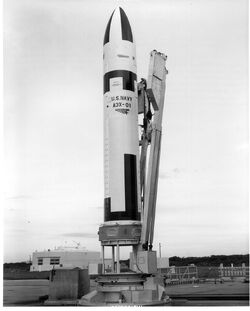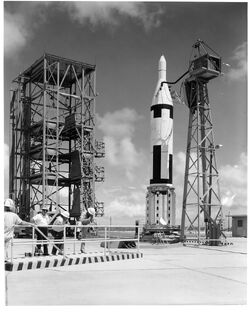
An UGM-27 Polaris ballistic missile is transferred between the U.S. Navy submarine tender USS Proteus (AS-19) and the ballistic missile submarine USS Patrick Henry (SSBN-599) at Holy Loch, Dunoon, Scotland (UK), 11 March 1961. Author: USN.
Missile data[]
| Statistic. | Data. |
|---|---|
| Type. | Submarine-launched ballistic missile. |
| Height. | 32 ft 4 in (9.86 m). |
| Diameter. | 4 ft 6 in (1,370 mm). |
| Weight. | 35,700 lb (16,200 kg). |
| Warhead. | 3 x W58 thermonuclear weapons. |
| Warhead yield. |
3 x 200Kt (Kilotonnes). |
| Accuracy (CEP). | 3,000 feet (910 m). |
| Speed. | 8,000 mph (13,000 km/h). |
| Steering. | Thrust vectoring. |
| Nationality. | U.S.A. |
| Made by. | Lockheed Corporation. |
| Guidance system. | Inertial. |
| Range. | 2,500 nautical miles (4,600 km). |
| First made. | 1960\61- prototype I\II, 1962- finnished product. |
| Retied on. | 1996. |
| Engines. | First stage, Aerojet General Solid-fuel rocket. Second stage, Hercules rocket, solid propellant. |
| Thrust. | N\A. |
| Sources. | http://www.designation-systems.net/dusrm/m-27.html, http://www.tandfonline.com/doi/abs/10.1080/13619460500100450, https://en.wikipedia.org/wiki/UGM-27_Polaris, http://www.tandfonline.com/doi/abs/10.1080/13619460500100450, https://en.wikipedia.org/wiki/UGM-27_Polaris and http://dictionary.sensagent.com/UGM-27%20Polaris/en-en/ |
- Missile data is the specifications for the Polaris A-3 (UGM-27C).

Polaris A-3 on launch pad prior to a test firing at Cape Canaveral. Author: U.S. Department of Defense.

Polaris A-1 on launch pad in Cape Canaveral. Author: U.S. Department of Defense.

A Polaris missile lifts off after being fired from the submerged British nuclear-powered ballistic missile submarine HMS Revenge (S27) off the coast of Florida (USA) near Cape Canaveral Air Force Station. This was the 10th in a series of Polaris test flights. on the 9th of June, 1983. Author: USN.

Polaris to Poseidon - 1966 Submarine & Missile Educational Documentary - Ella73TV
Documentary about the UGM-27 "Polaris" missile program. Shows many scenes of activities aboard submarines, construction, testing and launch of the Polaris missiles, and an overview of the missiles capabilities including the ability to carry high yield warheads. One of the key aspects of the Polaris program was the need to launch the missiles from underwater.
History[]
Origins[]
These missiles were used by both the United States Navy and Royal Navy. The Nazis had thought up and started to build a primitive prototype in the closing months of World War 2.
Usage[]
The Regulus missile program was deactivated with the advent of Polaris in the Pacific. The forward-basing arrangement was continued when Poseidon missile replaced Polaris, starting in 1972, in what by then were the 31 Atlantic Fleet SSBNs.
From the early days of the Polaris program, American senators and naval officers suggested that the United Kingdom might use Polaris. In 1957 Chief of Naval Operations Arleigh Burke and First Sea Lord Louis Mountbatten began corresponding on the project. After the cancellations of the Blue Streak and Skybolt missiles in the 1960s, under the 1962 Nassau Agreement that emerged from meetings between Harold Macmillan and John F. Kennedy, the United States would supply Britain with Polaris missiles, launch tubes, ReBs, and the fire-control systems. Britain would make its own warheads and initially proposed to build five ballistic missile submarines, later reduced to four by the incoming Labour government of Harold Wilson, with 16 missiles to be carried on each boat. The Polaris Sales Agreement was signed on April 6, 1963.
During its reconstruction program in 1957-1961, the Italian cruiser ''Giuseppe Garibaldi'' was fitted with four Polaris missile launchers located in the aft part of the ship. Successful tests held in 1961-1962 induced the United States to study a NATO Multilateral Nuclear Force (MLF), consisting of 25 international surface vessels from the US, United Kingdom, France, Italy, and West Germany, equipped with 200 Polaris nuclear missiles, enabling European allies to participate in the management of the NATO nuclear deterrent.
The MLF plan, as well as the Italian Polaris Program, were abandoned, both for political reasons (in consequence of the Cuban Missile Crisis) and the initial operational availability of the first SSBN George Washington, which was capable of launching SLBMs while submerged, a solution preferable to surface-launched missiles.
The USN had forward-basing arrangements for its Atlantic-based Polaris fleet with both the United Kingdom and Spain, permitting the use of bases at the Holy Loch navel base in Scotland (established in 1961) and at Naval Station Rota (Polaris base established 1964) in the Bay of Cadiz.
Demise[]
The Polaris missile was gradually replaced on 31 of the 41 original SSBNs in the US Navy by the MIRV-capable Poseidon missile beginning in 1972. During the 1980s, these missiles were replaced on twelve of these submarines by the Trident I missile. The ten George Washington- and Ethan Allen-class SSBNs retained Polaris A-3 until 1980 because their missile tubes were not large enough to accommodate Poseidon. With USS Ohio commencing sea trials in 1980, these submarines were disarmed and redesignated as attack submarines to avoid exceeding the SALT II strategic arms treaty limits.
Launching authority[]
The SACEUR (Supreme Allied Commander, Europe) had the authority to launch them in Europe.
Name[]
It is either said "Polaris", "Pol'laris", "pol'ar'iz", "Pola'ris", "Pol'arris" or "Pol'aris".